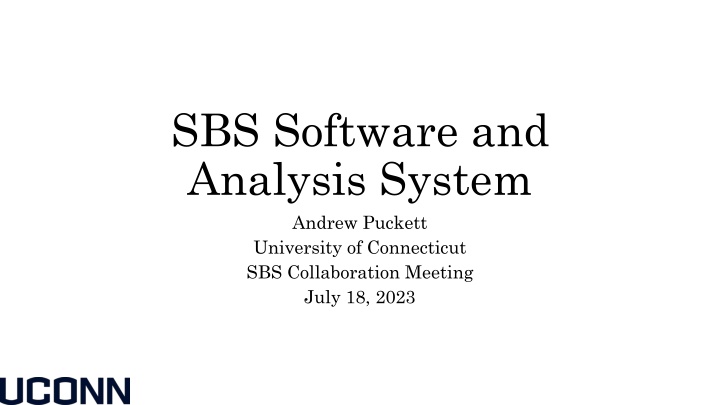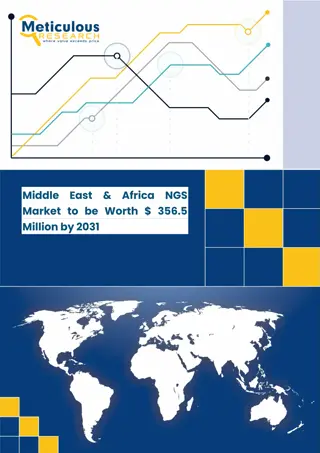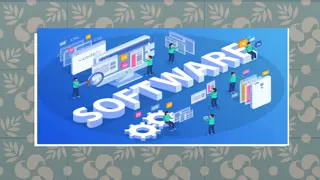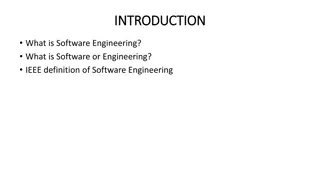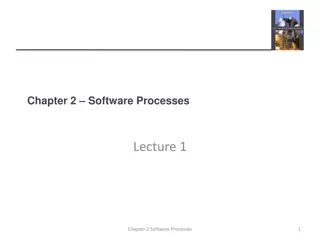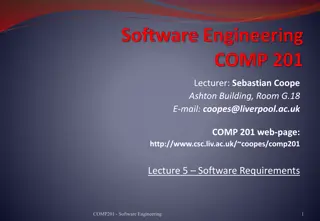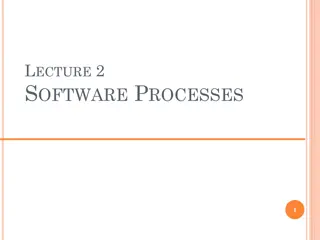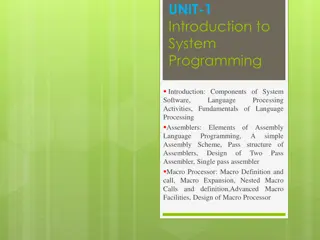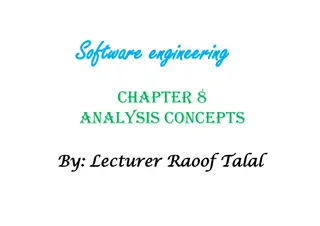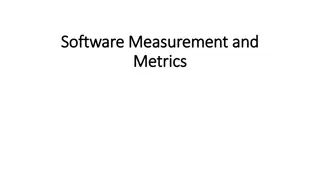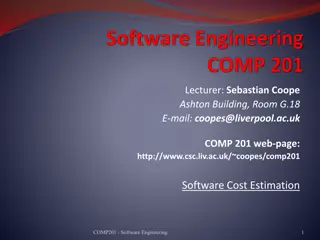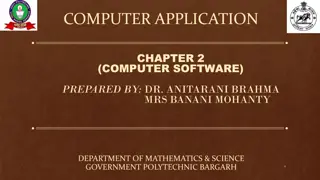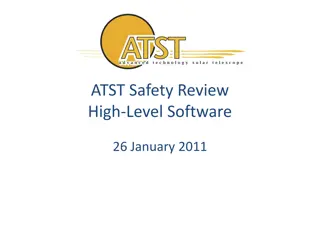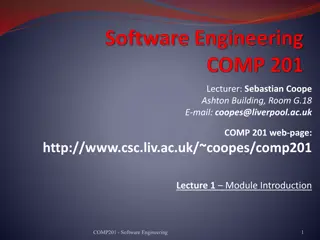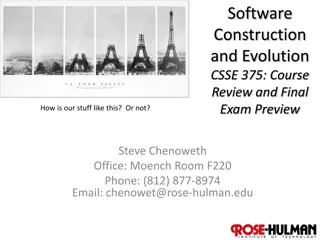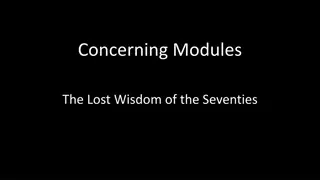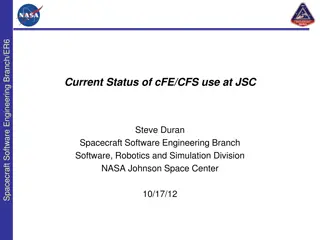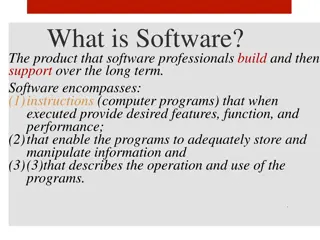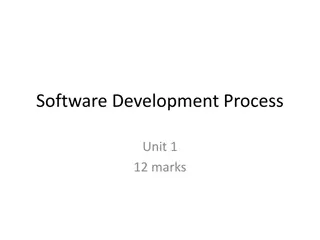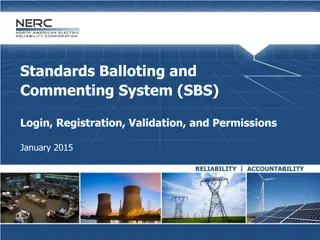SBS Software and Analysis System Overview
The SBS Software and Analysis System at the University of Connecticut involves various repositories for offline and online analysis software tools, including libraries for digitization, simulation, and reconstruction. The system is coordinated by Andrew Puckett and supports GEANT4-based simulation for SBS experiments. Dedicated meetings and collaborations drive the ongoing development and usage of these tools within the SBS research community.
Download Presentation

Please find below an Image/Link to download the presentation.
The content on the website is provided AS IS for your information and personal use only. It may not be sold, licensed, or shared on other websites without obtaining consent from the author.If you encounter any issues during the download, it is possible that the publisher has removed the file from their server.
You are allowed to download the files provided on this website for personal or commercial use, subject to the condition that they are used lawfully. All files are the property of their respective owners.
The content on the website is provided AS IS for your information and personal use only. It may not be sold, licensed, or shared on other websites without obtaining consent from the author.
E N D
Presentation Transcript
SBS Software and Analysis System Andrew Puckett University of Connecticut SBS Collaboration Meeting July 18, 2023
Meme-smithing by Jack Jackson 4/3/2024 4/3/2024 SBS Collaboration Meeting SBS Collaboration Meeting 2 2
Existing SBS Software SBS online/offline analysis software is based on Podd, the standard C++/ROOT-based Hall A analysis framework, and uses the ROOT-based panguin/OnlineGUI for online monitoring plots for shift workers. Existing repositories: SBS SBS- -offline offline: (primary authors: S. Riordan, A. Puckett, E. Fuchey, O. Hansen, J. C. Cornejo, M. Jones, R. Montgomery, D. Hamilton, S. Jeffas, et al.) https://github.com/JeffersonLab/SBS-Offline Main software repository of SBS-specific libraries and source code. Includes raw data decoders that aren t yet standardized under Podd for new readout modules such as MPD w/VTP and VETROC SBS-replay: (principal authors: A. Puckett, E. Fuchey, O. Hansen, S. Seeds, P. Datta, D. Hamilton, others) https://github.com/JeffersonLab/SBS-replay Repository for analyzer database files, replay scripts, analysis and calibration macros, online GUI configuration files, etc. No build system. Just a collection of files. This repo is needed to analyze GMN/nTPE data. Libsbsdig Libsbsdig: (principal author Eric Fuchey) https://github.com/JeffersonLab/libsbsdig Main library for digitization of simulation output; translates g4sbs output (hit time, position, energy deposit) into simulated raw detector signals ( pseudo-data ), populates hit data structures used by reconstruction (ADC, TDC, crate, slot, channel, etc); purpose is to test and develop reconstruction algorithms on simulated events using identical algorithms to those used for real data: Crucial for high Crucial for high- -rate tracking studies done with simulation so far rate tracking studies done with simulation so far G4sbs G4sbs: : (principal authors Andrew Puckett, Seamus Riordan, Eric Fuchey, many, many contributors) https://github.com/JeffersonLab/g4sbs GEANT4-based simulation of all of the major SBS experiments. Documentation at https://hallaweb.jlab.org/wiki/index.php/Documentation_of_g4sbs SBSGEM_standalone SBSGEM_standalone: : (principal author A. Puckett) https://github.com/ajpuckett/SBSGEM_standalone standalone GEM reconstruction code, takes decoded raw data (after common-mode/pedestal subtraction and zero suppression), does clustering, tracking, and alignment. Still useful here and there, but mostly superseded by analyzer/SBS-offline. No longer under active development. 4/3/2024 4/3/2024 SBS Collaboration Meeting SBS Collaboration Meeting 3 3
SBS software working group Mailing list: https://mailman.jlab.org/mailman/listinfo/Sbs_software Standing weekly meeting; currently Fridays at 1:00 PM SBS Software and Analysis Coordinator: Andrew Puckett SBS software/analysis wiki page: https://sbs.jlab.org/wiki/index.php/SBS_Software/GMN_analysis_meeti ng_agendas_and_minutes Dedicated GMN/nTPE analysis meetings; currently Fridays at 10:00 AM GEN analysis effort ramping up now Upcoming GEN-RP and GEP experiments 4/3/2024 4/3/2024 SBS Collaboration Meeting SBS Collaboration Meeting 4 4
What were up against (GMN run 13727, 12 uA LD2, ?2= 4.5 ???2,? = 4 ???) Single event display for BigBite GEMs; all fired strips color-coded by ADC values = approximate size of calorimeter-constrained track search region at each layer 4/3/2024 4/3/2024 SBS Collaboration Meeting SBS Collaboration Meeting 5 5
GEN Optics calibration (by Holly) https://sbs.jlab.org/cgi- bin/DocDB/private/ShowDocument?docid=344 Polarized Helium Polarized Helium- -3 Cell 3 Cell Carbon Foils Carbon Foils e e- - beam beam Reference Cell for H Reference Cell for H2 2, N unpolarized He unpolarized He- -3, etc. , N2 2, , 3, etc. Lessons learned from GMN experience allow pretty good starting optics model for BigBite from simulation 4/3/2024 4/3/2024 SBS Collaboration Meeting SBS Collaboration Meeting 6 6
GRINCH software Bottom of the GRINCH Plots and analysis credit: Maria Satnik Track x position Maira is working on implementing multiple clusters into SBS offline. 90% - 97% electron detection efficiency during GEn and 80% - 90% during GMn. Top of the GRINCH GRINCH Cluster Center [vertical row] Clear correlation between track position and GRINCH cluster position. Negative x is up in this transport coordinate system. Before Timing correction script created and implemented. After Satnik, 9 Jan 2023 Timing correction using GRINCH LED 4/3/2024 4/3/2024 SBS Collaboration Meeting SBS Collaboration Meeting 7 7
Analyzing downbending tracks in BigBite Motivation: obtain tagged neutron sample in ?? ??+ with pion in BigBite and neutron in HCAL using endpoint method Anuruddha Rathnayake (UVA) is working on downbending tracking analysis for GMN SBS-9 kinematics. SBS-4 also looks promising. We might also look to take dedicated opposite-polarity data with BigBite during GEN-RP with LH2 target and radiator (but polarimeter elements (analyzers) in the path of the neutrons would likely need to be removed) 4/3/2024 4/3/2024 SBS Collaboration Meeting SBS Collaboration Meeting 8 8
Selecting downbending tracks Replay data with no/loose tracking constraints at the FRONT of the GEMs Plot correlation between track vertical angle bb.tr.th and track vertical position bb.tr.x Upbending and downbending tracks separate into two distinct stripes Downbending Upbending 4/3/2024 4/3/2024 SBS Collaboration Meeting SBS Collaboration Meeting 9 9
Checking constraint calculation for downbending tracks Upbending mode constraint calculation (normal) Downbending mode constraint calculation Red (blue) is downbending (upbending) tracks when replaying data in downbending (left) and upbending (right) mode 4/3/2024 4/3/2024 SBS Collaboration Meeting SBS Collaboration Meeting 10 10
GEP geometry updated in g4sbs Electron Arm: High-T Lead-Glass (ECAL) + Scintillator planes (CDET) 30-cm LH2 target CH2 (HDPE) CH2 (HDPE) Analyzer, ~56 cm Analyzer, ~56 cm 85% polarized 85% polarized ? beam, (up to) 10.6 GeV, 70 (up to) 10.6 GeV, 70 ?A A beam, Proton Arm: SBS magnet (2.4 ? ?) and detectors Front (FT) and rear (FPP) GEM trackers for Front (FT) and rear (FPP) GEM trackers for proton reconstruction and polarimetry proton reconstruction and polarimetry https://github.com/JeffersonLab/g4sbs Hadron Calorimeter (HCAL) 4/3/2024 4/3/2024 SBS Collaboration Meeting SBS Collaboration Meeting 11 11
Updated ECAL/CDET geometry (by Kip Hunt (UConn)) Kip extracted ECAL geometry details from JT file provided by Hall A engineers Updated supermodule layout to (near) final Added inactive lead-glass, glass-foam insulation, and CH2 absorber CDET geometry has correct z position, but still a placeholder (waiting for CNU to release their CDET model into official g4sbs) 4/3/2024 4/3/2024 SBS Collaboration Meeting SBS Collaboration Meeting 12 12
SBS Software Early Successes A Brief History 4/3/2024 4/3/2024 SBS Collaboration Meeting SBS Collaboration Meeting 13 13
https://logbooks.jlab.org/entry/3924706 BigBite tracking and kinematic reconstruction ready and working on day 1 of GMN 4/3/2024 4/3/2024 SBS Collaboration Meeting SBS Collaboration Meeting 14 14
https://logbooks.jlab.org/entry/3924320 https://logbooks.jlab.org/entry/3925085 GEM track-based efficiency plateaus taken on first shift with beam 4/3/2024 4/3/2024 SBS Collaboration Meeting SBS Collaboration Meeting 15 15
https://logbooks.jlab.org/entry/3925220 Momentum/angle reconstruction verified with elastic scattering 4/3/2024 4/3/2024 SBS Collaboration Meeting SBS Collaboration Meeting 16 16
SBS GEM commissioning in GEN: https://logbooks.jlab.org/entry/4061825 4/3/2024 4/3/2024 SBS Collaboration Meeting SBS Collaboration Meeting 17 17
GEP ERRSBS GEM Tracking Efficiency Studies 4/3/2024 4/3/2024 SBS Collaboration Meeting SBS Collaboration Meeting 18 18
Elastic Yield Estimation from GMN data Elastic yield estimation from data Black = all events Black = all events Red = scaled elastic from Red = scaled elastic from coincidence with HCAL coincidence with HCAL Blue = estimated background Blue = estimated background GMN SBS9 Kinematics: GMN SBS9 Kinematics: Yield is charge-normalized, live-time corrected elastic peak integral most reliable proxy for overall tracking efficiency 4/3/2024 4/3/2024 SBS Collaboration Meeting SBS Collaboration Meeting 19 19
GEM Reconstruction Efficiency at High Rate g4sbs reproduces observed BigBite GEM rate/occupancy at low beam current (3 uA) High current study done at end of GMN went up to 34.5 uA on LH2, LD2 in previous slide s kinematics. Elastic yield Elastic yield drops rapidly with current (effect of GEM gain/efficiency drop Holly s talk) Simulated Simulated BigBite BigBite tracking efficiency efficiency shows much slower drop- off (without any fine-tuning or optimization) GEP GEP- -equivalent equivalent beam current for this configuration is ~120 (50) ?A for Front Tracker (Back Tracker) Implied 4/8 efficiency for SBS FT in GEP is ~70%, consistent with assumption in PAC47 uncertainty projections (rough, preliminary) tracking 4/3/2024 4/3/2024 SBS Collaboration Meeting SBS Collaboration Meeting 20 20
PRELIMINARY conclusions on GEM gain/efficiency during GMN The observed deviations from linearity of the excess divider current and the hit rate/occupancy are qualitatively consistent with the observed reductions in tracking efficiency* BigBite tracking was/is particularly vulnerable to this issue due to using only 5 GEM layers in tracker gain/efficiency drop required us to run GMN significantly below proposal luminosity (but we still got the physics!) Simulated BigBite tracking at various background levels (under stable gain assumption) shows that the efficiency reduction seen during GMN comes mostly (but not entirely) from the hardware. Parallel divider concept will mitigate this issue for GEP front tracker GEP polarimeter redesign with more redundant 8-layer tracking assemblies in front and back trackers will make the overall tracking far more robust against individual layer inefficiencies; small dead areas, intermittent localized hardware/electronics issues, etc. Hardware fix for gain drop will be verified during upcoming GEN-RP run *as measured by elastic yield, requiring 3/5 layers to form a track 4/3/2024 4/3/2024 SBS Collaboration Meeting SBS Collaboration Meeting 21 21
NEW--SBS optics calibrations from GEN data w/SBS GEMs At GEN Kin-2 we have H2 reference cell data at 30% and 100% SBS field with SBS GEMs in the data stream Q^2 is relatively low, elastic event selection with W2 and HCAL is extremely clean Can calibrate angle and vertex reconstruction extremely well Momentum calibration still a work in progress due to overfitting issues (too few independent constraints) formalism needs some development 4/3/2024 4/3/2024 SBS Collaboration Meeting SBS Collaboration Meeting 22 22
GEN-2 Invariant Mass (H2 Ref. Cell, SBS 30% and 100% field) 1000 1200 1400 1600 200 400 600 800 0 2 - 10000 12000 2000 4000 6000 8000 0 1 - W2 (GEN-2, SBS 30% field) 0 0 1 GEN-2, SBS 100% field 2 2 3 4 4 5 6 6 W^2 (GeV Std Dev 1.707 Std Dev 1.707 Mean Mean Entries Entries htemp htemp 7 2 W (GeV ) 2 8 2 ) 3.177 3.177 47132 47132 Background lower with 100% field due to more sweeping of inelastic particles 4/3/2024 4/3/2024 SBS Collaboration Meeting SBS Collaboration Meeting 23 23
Target ? reconstruction (SBS 30% field) expected (rad) tgt q 0.15 - 0.10 - 0.05 - 0.00 0.05 0.10 0.15 0.15 - Std Dev y 0.0595 Std Dev y 0.0595 Std Dev x 0.05969 Std Dev x 0.05969 Mean y 0.006695 Mean y 0.006695 Mean x 0.006704 Mean x 0.006704 Entries Entries hthtar_corr hthtar_corr 0.10 - 8341 8341 0.05 - 0.00 0.05 tgt q predicted (rad) 0.10 0.15 0 5 10 15 20 25 100 150 200 250 300 350 400 0.05 - 0.04 - 0.03 - 0.02 - 0.01 - 0.00 0.01 0.02 0.03 0.04 0.05 50 0 Sigma Sigma Mean - Mean 5.061e 05 - Constant Constant 2c 2c Std Dev Std Dev Mean Mean Entries Entries / ndf / ndf - 5.061e hdthtar hdthtar 0.003906 0.003906 05 - 4.334e - - 9.048e tgtqD 213.9 / 125 213.9 / 125 332 332 0.000035 4.334e 9.048e 0.000035 0.004635 0.004635 8341 8341 4.7 4.7 05 - 05 - 06 - 06 - 4/3/2024 4/3/2024 SBS Collaboration Meeting SBS Collaboration Meeting 24 24
Target ? reconstruction (SBS 30% field) expected (rad) tgt f 0.06 - 0.04 - 0.02 - 0.00 0.02 0.04 0.06 0.06 - - Std Dev y 0.02184 Std Dev y 0.02184 Std Dev x 0.0224 Std Dev x 0.0224 Mean y 0.009536 Mean y 0.009536 Mean x 0.009539 Mean x 0.009539 Entries Entries hphtar_corr hphtar_corr 0.04 - 0.02 0.00 0.02 0.04 0.06 0.08 8341 8341 f tgt predicted (rad) 0 5 10 15 20 25 30 100 150 200 250 300 350 0.05 - 0.04 - 0.03 - 0.02 - 0.01 - 0.00 0.01 0.02 0.03 0.04 0.05 50 0 Sigma Sigma Mean 0.0001669 Mean 0.0001669 0.0000494 Constant Constant 2c 2c Std Dev Std Dev Mean Mean Entries Entries / ndf / ndf hdphtar hdphtar 0.004406 0.004406 - 7.061e - tgt fD 275.8 / 106 275.8 / 106 292.1 292.1 0.000045 0.0000494 7.061e 0.000045 0.004948 0.004948 8341 8341 4.4 4.4 06 - 06 - 4/3/2024 4/3/2024 SBS Collaboration Meeting SBS Collaboration Meeting 25 25
y target reconstruction (SBS 30% field) y measured (m) tgt 0.20 - 0.15 - 0.10 - 0.05 - 0.00 - 0.05 0.10 0.15 0.20 0.20 - 0.15 - 0.10 - 0.05 - 0.00 - 0.05 0.10 0.15 0.20 Std Dev y 0.06365 Std Dev y 0.06365 Std Dev x 0.06522 Std Dev x 0.06522 Mean y 0.01474 Mean y 0.01474 Mean x 0.01486 Mean x 0.01486 Entries Entries hytar_corr hytar_corr - - - - 8341 8341 y tgt predicted (m) 0 2 4 6 8 10 12 14 16 18 20 22 24 100 150 200 250 300 0.10 - 0.08 - 0.06 - 0.04 - 0.02 - 0.00 0.02 0.04 0.06 0.08 0.10 50 0 Sigma Sigma Mean 0.0001553 Mean 0.0001553 0.0001049 Constant Constant 2c 2c Std Dev Std Dev Mean Mean Entries Entries / ndf / ndf hdytar hdytar 0.009322 0.009322 y D tgt - - 3.268e 270.3 270.3 426.8 / 166 426.8 / 166 (m) 0.0001049 0.000103 3.268e 0.000103 0.0122 0.0122 8341 8341 4.3 4.3 05 - 05 - 4/3/2024 4/3/2024 SBS Collaboration Meeting SBS Collaboration Meeting 26 26
Target ? reconstruction (SBS 100% field) q measured (rad) tgt 0.15 - 0.10 - 0.05 - 0.00 0.05 0.10 0.15 0.15 - Std Dev y 0.03718 Std Dev y 0.03718 Std Dev x 0.03738 Std Dev x 0.03738 Mean y 0.08129 Mean y 0.08129 Mean x 0.08117 Mean x 0.08117 Entries Entries hthtar_corr hthtar_corr 0.10 - GEN-2, SBS 100% 66340 66340 0.05 - 0.00 0.05 tgtq predicted (rad) 0.10 0.15 0 20 40 60 80 100 120 1500 140 160 2000 180 200 2500 220 1000 500 0.05 - 0.04 - 0.03 - 0.02 - 0.01 - 0.00 0.01 0.02 0.03 0.04 0.05 0 Sigma 0.004029 0.000014 Sigma 0.004029 Mean 5.633e 06 - Mean - Constant Constant 2c 2c Std Dev Std Dev Mean Mean Entries Entries / ndf / ndf - 5.633e hdthtar hdthtar tgt qD 06 - 1.600e (rad) 2528 2528 - - 2443 / 243 2443 / 243 1.600e 3.893e 3.893e 0.000014 0.005842 0.005842 66340 66340 13.3 13.3 05 - 05 - 05 - 05 - 4/3/2024 4/3/2024 SBS Collaboration Meeting SBS Collaboration Meeting 27 27
Target ? reconstruction (SBS 100% field) f measured (rad) tgt 0.10 - 0.08 - 0.06 - 0.04 - 0.02 - 0.00 0.02 0.04 0.06 0.08 0.10 0.10 - 0.08 - 0.06 - 0.04 - 0.02 - 0.00 0.02 0.04 0.06 0.08 0.10 Std Dev y 0.021 Std Dev y 0.021 Std Dev x 0.02188 Std Dev x 0.02188 Mean y 0.01276 Mean y 0.01276 Mean x 0.01279 Mean x 0.01279 Entries Entries hphtar_corr hphtar_corr GEN-2, SBS 100% 66340 66340 f tgt predicted (rad) 0 20 40 60 80 100 1400 120 1600 140 160 2200 1000 1200 1800 2000 2400 200 400 600 800 0.05 - 0.04 - 0.03 - 0.02 - 0.01 - 0.00 0.01 0.02 0.03 0.04 0.05 0 Sigma 0.004782 0.000018 Sigma 0.004782 Mean 0.0004352 0.0000192 Mean 0.0004352 Constant Constant 2c 2c Std Dev Std Dev Mean Mean Entries Entries / ndf / ndf hdphtar hdphtar fD tgt (rad) - - 2111 2111 3083 / 192 3083 / 192 0.0000192 2.539e 2.539e 0.000018 0.006117 0.006117 66340 66340 11.5 11.5 05 - 05 - 4/3/2024 4/3/2024 SBS Collaboration Meeting SBS Collaboration Meeting 28 28
y target reconstruction (SBS 100% field) measured (m) tgt y 0.20 - 0.15 - 0.10 - 0.05 - 0.00 - 0.05 0.10 0.15 0.20 0.20 - 0.15 - - Std Dev y 0.06396 Std Dev y 0.06396 Std Dev x 0.06607 Std Dev x 0.06607 Mean y 0.02389 Mean y 0.02389 Mean x - 0.0239 Mean x - Entries Entries hytar_corr hytar_corr - - GEN-2, SBS 100% 0.10 - 0.0239 66340 66340 0.05 - 0.00 0.05 0.10 0.15 0.20 y tgt predicted (m) 0 20 40 60 80 100 120 2000 1000 1200 1400 1600 1800 2200 200 400 600 800 0.10 - 0.08 - 0.06 - 0.04 - 0.02 - 0.00 0.02 0.04 0.06 0.08 0.10 0 Sigma Sigma Mean 0.0001119 Mean 0.0001119 0.0000427 Constant Constant 2c 2c Std Dev Std Dev Mean Mean Entries Entries / ndf / ndf hdytar hdytar 0.01069 0.01069 y D tgt 1887 1887 - - 2913 / 246 2913 / 246 (m) 0.0000427 4.692e 4.692e 0.00004 0.00004 0.01398 0.01398 66340 66340 10.4 10.4 05 - 05 - 4/3/2024 4/3/2024 SBS Collaboration Meeting SBS Collaboration Meeting 29 29
Summary/conclusions GMN/GEN software effort was an unqualified, smashing success: Ready on day 1 of beam for detector commissioning rapid understanding of GEM performance Rapid analysis progress for entirely new detector systems First large-scale deployment of GEMs in Hall A high-luminosity environment Rapid, efficient (in memory/CPU) processing of big (2 PB) dataset (down to <5 TB in first reconstruction pass) Well-developed, mature simulation and reconstruction infrastructure, with working machinery to robustly benchmark algorithm performance under realistic background rate conditions (and test changes/improvements) New code(s) needed for GEP/GEN-RP are mostly incremental additions to codes developed for GMN/GEN, which are flexible, modular and reusable Much of the remaining work is in the development of reconstruction/calibration/monitoring tools for ECAL/CDET and SBS optics/spin tracking We have a clear solution path forward to achieve acceptable high-rate performance of GEM hardware and software Thank you for your attention: questions? 4/3/2024 4/3/2024 SBS Collaboration Meeting SBS Collaboration Meeting 30 30
Backups 4/3/2024 4/3/2024 SBS Collaboration Meeting SBS Collaboration Meeting 31 31
How Generic SBS GEM Tracking Works (Simplistically): All SBS GEMs are planar with two non-parallel readout strip orientations; each GEM layer measures one point along the track in 3D space First step is baseline estimation and subtraction and zero suppression (online and/or offline) 1D clustering of strips along each dimension in each GEM chamber Form all possible 2D combinations from 1D clusters within calorimeter-defined search region, subject to some basic quality cuts Number of fake 2D hit candidates is proportional to the Number of fake 2D hit candidates is proportional to the square square of the number of real hits! of the number of real hits! Filter 2D hits according to criteria such as cluster ADC sum, X/Y (or U/V) ADC asymmetry and correlation coefficient, timing, etc. Divide each tracking layer into a uniform 2D rectangular grid, accumulate a list of (2D) hit candidates in each grid bin. When GEMs are aligned internally, we currently use grid bin width of 1 x 1 cm^2 (bin size ~100X spatial resolution along each dimension) Loop on all possible combinations of one hit from the two outermost layers (within region of interests defined by other detectors) Form straight-line projection from hits in outermost layers to inner layers. Loop on all possible combinations of one hit from each inner layer, in grid bins consistent with straight line projection from outer layers, find the hit combination with best ?2 ???(and possibly other criteria). Definition of good track is based on a user-defined maximum ?2 We also impose some basic track quality/track slope/optics-based constraints on track candidates internally to the track-finding algorithm to reject obviously bad hit combinations within the search region Initially, we require hits on all 5 layers. If we don t find a track at the maximum hit requirement, we decrease the hit requirement by one and repeat for all possible combinations of 4 out of 5 layers, then all possible combinations of 3 out of 5. We do not consider two-hit tracks as they have no degrees of freedom (we can always draw a straight line between any two points). We repeat these iterations until we run out of unused hits in the search region. With a 3-hit minimum, the fake track probability is significant at high rates More hits = more confidence that the track is real At a given minimum hit requirement, we treat all possible layer combinations on an equal footing, but this could be questionable given the tracking geometry. ??? 4/3/2024 4/3/2024 SBS Collaboration Meeting SBS Collaboration Meeting 32 32
GEM hit rates and divider currents during GMN 120 G4SBS (layer 0-3 average) G4SBS (layer 4) Layer 0 Layer 1 Layer 2 Layer 3 Layer 4 100 Cluster Multiplicity per event (U strips) 80 60 40 20 0 0 5 10 Beam current (uA), SBS-9 15-cm LH2 15 20 25 30 35 4/3/2024 4/3/2024 SBS Collaboration Meeting SBS Collaboration Meeting 33 33
Benchmarking g4sbs GEM background rates Run 13656, 3 Run 13656, 3 uA uA, LH2 target (no timing cuts) , LH2 target (no timing cuts) G4SBS simulated background @3 G4SBS simulated background @3 uA uA, LH2 target , LH2 target 200 400 600 0.5 1.5 10 20 30 40 4 6 Average clusters/event = 12.49 0 0 2 0 2 Average clusters/event = 1.38 0 1 0 0 10 20 30 40 0 10 10 10 0 Average clusters/event = 1.84 Average clusters/event = 10.04 Hit rate = 13.88 (kHz/cm Hit rate = 5.84 (kHz/cm Hit rate = 4.38 (kHz/cm Hit rate = 11.16 (kHz/cm 3 U/X strips 3 U/X strips 3 U/X strips 20 40 60 80 U/X strips 10 Total number of clusters/event 5 Total number of clusters/event Total number of clusters/event Total number of clusters/event 10 20 ) 2 ) 2 ) 2 ) 2 15 30 200 400 600Average clusters/event = 12.39 0.5 1.5 Average clusters/event = 2.01 10 20 30 4 6 0 0 2 0 0 1 0 20 40 60 80 0 0 10 10 0 10 Average clusters/event = 2.34 Average clusters/event = 13.04 Hit rate = 14.49 (kHz/cm Hit rate = 7.44 (kHz/cm Hit rate = 6.39 (kHz/cm Hit rate = 13.76 (kHz/cm 3 U/X strips 3 U/X strips 3 U/X strips 10 U/X strips 5 20 Total number of clusters/event Total number of clusters/event Total number of clusters/event Total number of clusters/event 10 15 20 40 30 ) 2 ) 2 ) 2 ) 2 200 400 0.5 1.5 Average clusters/event = 2.10 10 20 4 6 0 0 2 0 0 1 0 0 0 10 10 0 10 Average clusters/event = 2.83 Average clusters/event = 14.21 Average clusters/event = 10.31 Hit rate = 9.00 (kHz/cm Hit rate = 15.79 (kHz/cm Hit rate = 6.67 (kHz/cm Hit rate = 11.45 (kHz/cm 3 U/X strips 3 U/X strips 3 U/X strips 10 20 30 40 20 40 60 U/X strips 5 20 Total number of clusters/event Total number of clusters/event Total number of clusters/event Total number of clusters/event 10 15 40 ) 2 ) 2 ) 2 ) 2 200 400 0.5 1.5 10 20 30 4 6 0 0 2 0 0 1 0 0 0 10 10 0 10 Average clusters/event = 2.41 Average clusters/event = 9.99 Average clusters/event = 2.02 Average clusters/event = 15.44 Hit rate = 11.10 (kHz/cm Hit rate = 7.65 (kHz/cm Hit rate = 6.43 (kHz/cm Hit rate = 17.16 (kHz/cm 3 U/X strips 3 U/X strips 3 U/X strips 10 20 30 20 U/X strips 5 20 Total number of clusters/event Total number of clusters/event Total number of clusters/event Total number of clusters/event 10 15 40 40 60 ) 2 ) 2 ) 2 ) 2 60 At low beam current (3 uA on 15-cm LH2), reconstructed cluster multiplicities per event agree between real data and Monte Carlo to within a factor ~1.5 without any fine-tuning of simulated pedestal/common-mode noise, GEM gain, zero suppression thresholds, electronics effects like crosstalk, etc. Suggests g4sbs rate estimate is more reliable than initially feared, after full digitization and reconstruction with simulated beam-induced background, under conditions where GEM gain/efficiency drop were not significant during GMN! 4/3/2024 4/3/2024 SBS Collaboration Meeting SBS Collaboration Meeting 34 34
Comparing g4sbs and real data at high beam current Run 13789, 30 Run 13789, 30 uA uA, LH2 target (no timing cuts) , LH2 target (no timing cuts) G4SBS simulated background @30 uA, LH2 target 200 400 600 100 200 0.5 1.5 4 Average clusters/event = 9.77 0 2 3 0 2 0 0 1 1 0 0 0 0 10 10 Average clusters/event = 43.87 Average clusters/event = 11.54 Average clusters/event = 84.69 Hit rate = 31.07 (kHz/cm Hit rate = 48.74 (kHz/cm Hit rate = 36.69 (kHz/cm Hit rate = 94.10 (kHz/cm 3 U/X strips 3 U/X strips 50 100 150 U/X strips U/X strips 20 Total number of clusters/event 50 Total number of clusters/event 20 Total number of clusters/event Total number of clusters/event 40 100 40 ) 2 ) 2 ) 2 ) 2 60 200 400 100 200 0.5 1.5 4 Average clusters/event = 11.20 0 2 3 0 2 Average clusters/event = 45.23 0 0 1 1 0 50 100 150 200 0 0 0 10 10 Average clusters/event = 105.05 Average clusters/event = 16.93 Hit rate = 50.25 (kHz/cm Hit rate = 116.72 (kHz/cm Hit rate = 35.62 (kHz/cm Hit rate = 53.83 (kHz/cm 3 U/X strips 3 U/X strips U/X strips U/X strips 20 Total number of clusters/event 20 Total number of clusters/event 50 Total number of clusters/event Total number of clusters/event 40 40 100 ) 2 ) 2 ) 2 ) 2 60 60 200 400 100 200 0.5 1.5 0 2 3 0 2 0 0 1 1 0 0 0 10 10 Average clusters/event = 12.92 Average clusters/event = 38.17 Average clusters/event = 119.99 Average clusters/event = 17.04 Hit rate = 41.07 (kHz/cm Hit rate = 42.41 (kHz/cm Hit rate = 133.33 (kHz/cm Hit rate = 54.17 (kHz/cm 50 100 150 200 3 U/X strips 3 U/X strips 20 U/X strips U/X strips 20 Total number of clusters/event 50 Total number of clusters/event Total number of clusters/event Total number of clusters/event 40 40 100 60 ) 2 ) 2 ) 2 ) 2 60 200 400 100 150 200 0.5 1.5 50 4 Average clusters/event = 11.20 0 2 3 0 2 0 0 1 1 0 0 0 10 10 Average clusters/event = 37.65 Average clusters/event = 130.27 Average clusters/event = 16.90 Hit rate = 35.61 (kHz/cm 50 100 150 200 Hit rate = 41.84 (kHz/cm Hit rate = 144.74 (kHz/cm Hit rate = 53.72 (kHz/cm 3 U/X strips 3 U/X strips U/X strips U/X strips 20 Total number of clusters/event 20 Total number of clusters/event 50 Total number of clusters/event Total number of clusters/event 40 40 100 ) 2 ) 2 ) 2 ) 2 60 60 At high beam current (30 uA LH2), the cluster multiplicities per event still roughly agree with g4sbs for the back GEM layer, but are much lower (2-3X) for the front 4 layers, indicating a significant gain/efficiency drop for the first four layers, roughly consistent with the observed reduction in elastic yield. (Note: GEM gain drop versus hit rate is not included in the simulation) 4/3/2024 4/3/2024 SBS Collaboration Meeting SBS Collaboration Meeting 35 35
